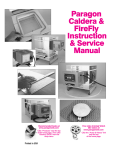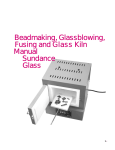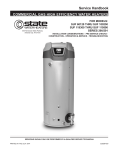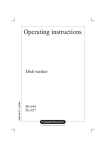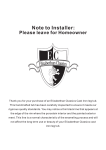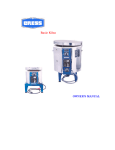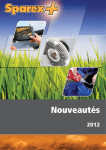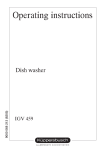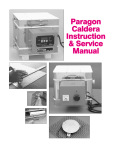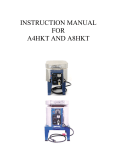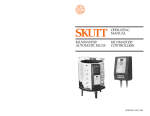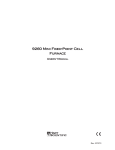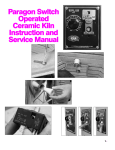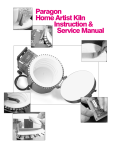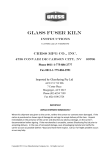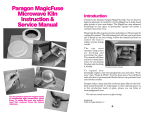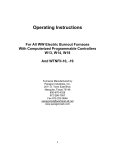Download Paragon Ceramic Fiber Jewelry Kiln Instruction & Service Manual
Transcript
Paragon Ceramic Fiber Jewelry Kiln Instruction & Service Manual You are about to enter the magical world of kiln-fired jewelry. To safely find your way around and to master your kiln, read this manual. Save for future reference. Free video training! Watch kiln videos at www.paragonweb.com Click the “Kiln Audio & Video” link on the left side of the home page. 1 Introduction Thank you for choosing a Paragon kiln! We have designed it to give you many years of reliable service. Contents Basic Kiln Set Up 4 Basic Operation 5 Silver & Gold Clay 10 Glass Fusing & Slumping 13 Annealing Beads 15 Tremendous stresses are generated within the kiln. The ceramic fiber firing chamber actually expands and contracts with each firing. Do not be concerned if small cracks appear in the fiber. This is normal. These are surface cracks that close tightly when the heated fiber expands. You may find a small pin hole in the center of the firing chamber. It is from the manufacturing process and will not affect the kiln’s performance. Enameling on Metal 16 Ceramic Overglaze & Decals 17 The paint and the ceramic fiber around the door will eventually discolor from heat. This will not affect the kiln’s performance. Lost Wax Burnout 19 Firing Mistakes 20 Kiln Maintenance 21 This manual includes answers to the most common questions we have been asked; reading it will ultimately save you time and help you master your kiln. Your instruction packet also includes a separate digital controller manual. Please save both manuals. When you receive your kiln, check the carton for damage. Check the kiln for both interior and exterior damage. If the kiln is damaged, you can refuse the shipment and have it returned, or accept the shipment after having the driver note the damage on the Bill of Lading. Then call Paragon at 800-876-4328 or 972-288-7557 (open Monday to Thursday, 7 A.M. to 5:30 P.M. Central). Check the Bill of Lading to insure that you received the correct number of packages. Note any shortages on the Bill of Lading, and have the driver sign the copy. If there were no signs of visible kiln damage and you discover it after the driver has left, notify the shipper immediately. It was carefully designed to provide maximum protection during shipping. Use the carton to take the kiln to seminars or on vacation, or to return the kiln to the factory for repairs. During firing, you will hear an intermittent, distinct clicking. This is the sound of the relay(s) sending power to the heating elements. Do not be concerned with this sound. During the first firing, you may also smell an odor from your kiln. This is normal and is caused by the burning of binders in the ceramic fiber firing chamber. This odor is accompanied by a discoloration, which will disappear after the kiln reaches about 1000°F. Important information about your kiln is recorded on its electrical data plate, which is mounted to the side of the kiln. Please include this information when ordering parts or calling your dealer or the factory about your kiln. Special thanks to Ed Biggar, Martha Biggar, Sallie Bly, and Patricia Walton for their many suggestions. 2 ©2001, by Paragon Industries, Inc. IM-164/5-11 Electrical Installation . . . . . . . . . . . . . . . . . 4 Where to Locate the Kiln . . . . . . . . . . . . . . 4 How to Transport the Kiln . . . . . . . . . . . . . 4 Accessories . . . . . . . . . . . . . . . . . . . . . . . . 5 Important Guidelines . . . . . . . . . . . . . . . . . 6 Loading the Kiln . . . . . . . . . . . . . . . . . . . . . 7 Venting the Kiln . . . . . . . . . . . . . . . . . . . . . 9 Looking Into a Hot Kiln. . . . . . . . . . . . . . . . 9 Drying Time . . . . . . . . . . . . . . . . . . . . . . . . 10 Loading the Kiln . . . . . . . . . . . . . . . . . . . . 10 Venting the Kiln . . . . . . . . . . . . . . . . . . . . . 10 Rate, Temperature, Hold. . . . . . . . . . . . . . 10 Cooling the Piece . . . . . . . . . . . . . . . . . . . 11 Combining Silver Clay With Other Materials . . . . . . . . . . . . . . . . 11 Frequently Asked Silver Clay Questions. . 11 How to Cut Glass . . . . . . . . . . . . . . . . . . . 13 Fusing Compatibility of Glass . . . . . . . . . . 13 The Annealing Range . . . . . . . . . . . . . . . . 14 Cleaning and Gluing the Glass . . . . . . . . . 14 Loading the Kiln . . . . . . . . . . . . . . . . . . . . 14 Firing the Glass . . . . . . . . . . . . . . . . . . . . . 14 Preparing and Decorating the Copper . . . 16 Firing Enamel . . . . . . . . . . . . . . . . . . . . . . 17 Pyrometric Cones . . . . . . . . . . . . . . . . . . . 17 Loading and Firing Overglaze. . . . . . . . . . 18 Silver Clay, Glass . . . . . . . . . . . . . . . . . . . 20 Ceramic Overglaze . . . . . . . . . . . . . . . . . . 21 Please visit www.paragonweb.com for videos on maintaining your kiln. Circuit Breaker Trips . . . . . . . . . . . . . . . . . 21 Temperature is Inaccurate . . . . . . . . . . . . 21 Temperature is Uneven. . . . . . . . . . . . . . . 21 Changing the Door . . . . . . . . . . . . . . . . . . 22 Door Latch Spring Adjustment . . . . . . . . . 22 Adjusting a Door That Won’t Stay Shut . . 22 Ceramic Fiber Repair . . . . . . . . . . . . . . . . 23 Cleaning or Replacing the Glass Viewing Port . . . . . . . . . . . . . . . . . . 24 Replacing the Thermocouple . . . . . . . . . . 24 Replacing a Relay or Transformer . . . . . . 25 Replacing the Temperature Controller . . . 26 Testing the Heating Element. . . . . . . . . . . 26 Repairing an Element Connector . . . . . . . 27 Safety Overfiring The warranty on your Paragon kiln does not cover damage from overfiring, regardless of the circumstances. It is the operator’s responsibility to make sure the kiln turns off at the proper time. The Ceramic Fiber Avoid touching the firing chamber surface with sharp or pointed objects. They can damage the fiber surface. Touching the embedded heating element with sharp or pointed objects is a shock hazard. Read the Manual! G Do not leave kiln unattended while firing. G Wear safety glasses when cutting glass. G G G G G G Read each page of this manual in detail before operating your kiln. Warranty does not cover damage caused by failure to follow instructions. Food or Drink Surfaces Some decorative materials may be unsafe and toxic when used for surfaces that will be in contact with food or drink. When you m ake food or drink containers, select a glaze or glass that has been formulated, tested, and labeled as approved for surfaces that will be in contact with food or drink. Follow the glaze or glass manufacturer’s instructions exactly, without any variations. G G Important Safety Rules An electric kiln is extremely safe to operate provided you follow these basic safety rules: G G Unplug kiln when not in use. G Do not touch hot sides. G Keep unsupervised children away. G Place kiln on a non-combustible surface. G Do not install closer than 12” from any wall or combustible surface. G G G G G G Fire only in a well ventilated, covered and protected area. Keep cordset away from hot sides of kiln. DANGEROUS VOLTAGE: Do not touch heating elements with anything. G Wear green #3 firing safety glasses, and keep your face at least 15” away when looking into a hot kiln. Keep food away from your work area. Never fire tempered glass inside a kiln. It could explode. Avoid firing toxic materials inside the kiln, such as styrofoam (used as a core for hollow beads). When firing cork clay as a filler, keep the kiln door closed between 500° - 800°F / 260° - 426°C. This is to prevent the cork from flaming out. Keep the kiln door closed when the kiln is not in use. This keeps dust out of the kiln. Also, should someone turn on the kiln while you are away, the closed door will keep the heat safely inside the firing chamber. Never place papers and other combustibles on top of the kiln, even when the kiln is idle. If people become accustomed to storing objects on the kiln, they may forget and do that while the kiln is firing. Fire only approved materials purchased from a knowledgeable supplier. Do not fire marbles, pieces of concrete, rocks, and other objects. Rapid heating to high temperature can cause violent reactions in many materials. Greenware, which is unfired clay, must be bone dry before firing. Moist greenware can explode inside the kiln, damaging the kiln. Place a piece of greenware against the inside of your wrist. If it feels cool, it is too wet to fire. Store kiln shelves in a dry area. Moist shelves can explode inside a kiln. If you smell burning plastic, turn the kiln off. Examine the wall outlet and supply cord for signs of burning. Remove flammable materials from the kiln room. Disconnect kiln before servicing. 3 Basic Kiln Set Up Electrical Installation You must plug your kiln into a circuit that no other appliance uses while the kiln is firing. Turn off the circuit breaker or unscrew the fuse for the circuit that your kiln will be plugged into. Check to see if other appliances shut off too. If that circuit powers appliances that must remain on while the kiln is firing, plug your kiln into a different circuit. Note: 120 volt kilns: avoid extension cords if possible. If you must use one, never use one smaller than 12 gauge and longer than 20 feet. Never plug it into a ceiling outlet! Voltage fluctuation can vary firing time from as little as half to more than twice the average time. If the voltage is too low, the kiln may never reach full temperature. The receptacle must have a separate safety grounding wire. This protects you from serious electrical shock. Changing the cord plug will void your warranty! Where to Locate the Kiln Many people store their kiln on a small steel cart with casters. When they fire the kiln, they move the cart near an open window or even take it outside. Place your kiln in a well ventilated, covered, and protected area such as the garage, basement, utility, or hobby room. Note: Some people keep their kiln outside on a covered patio. This is okay so long as the kiln is not subjected to excessive humidity. We recommend good ventilation especially when you fire decals, china paint, lost wax casting, and silver clay filler materials such as cork clay. However, some materials, such as silver clay fired alone, may not need special ventilation. Remove gasoline, paint, and other flammable materials from the kiln room. Provide a minimum of 12 inches clearance between kiln and the closest wall. Never allow the room temperature of your firing room to exceed 100 - 110° F. Measure the temperature about 3 feet from the kiln. If necessary, use fans to lower room temperature. 4 Keep the kiln away from curtains or other combustible materials. Position kiln on a level, fire-proof surface. We recommend an 18” x 18” piece of sheet metal, a large ceramic tile, or a large ceramic kiln shelf. Place the kiln on a fire-proof surface, such as a large ceramic kiln shelf. Note: If you are with the kiln at all times during firing, you can place it directly onto a workbench or kitchen table. A fire-proof surface is ideal, though, because it provides a safe place to lay hot shelves removed from the kiln. But remember that heat can transfer through the ceramic shelf to the surface underneath. Keep unsupervised children away. Keep the power supply cord away from the kiln case. When storing the kiln, do not lay flammable materials such as papers on top. It is too easy to forget to remove them when you fire the kiln. There is little danger of serious burn from accidental contact if you exercise the same caution you would use with an electric iron. How to Transport the Kiln Some people take their kilns to seminars or on vacation. The easiest way to transport the kiln is to use the original packing materials. If you no longer have the packing materials, transport the kiln on its back with the door facing up. Place a thin sheet of foam cushioning between the door and the firing chamber to prevent rubbing. Avoid subjecting the kiln to excessive vibration during travel. Basic Operation Accessories Ceramic Fiber Shelves The soft ceramic fiber shelf, which comes standard with the kiln, cradles gold and silver clay pieces. These shelves are not suitable for firing glass or ceramics. Ceramic Fiber Blanket Delicate silver or gold clay shapes may need extra support during firing to prevent warping. Place these shapes on a piece of ceramic fiber blanket. Stilts Stilts are high temperature wire points embedded in a ceramic base. The points separate enameling and glazed ceramics from the shelf. Ceramic Fireclay Shelves & Posts Ceramic fireclay shelves, available from Paragon, are hard ceramic surfaces on which to fire ceramics and glass. Firing glass, enameling, and ceramic glazes directly on the firing chamber bottom would ruin the bottom. Shelves can be stacked using posts. Glass Separator & Kiln Wash Glass separator and kiln wash are mixtures of finely ground minerals that will not melt and fuse together at high temperatures. They prevent glass and ceramic glaze from sticking to fireclay shelves. The main difference between glass separator and kiln wash is that the separator is ground more finely to leave a smooth back to glass pieces laid on the shelf. As powders, glass separator and kiln wash have an unlimited shelf life. Do not breathe the powder when mixing. Caution: If glass separator or kiln wash contact a heating element, that element will burn out in the next firing. NEVER apply glass separator or kiln wash to the ceramic fiber firing chamber. Haik Brush The haik brush is used to apply glass separator to the kiln shelf in a smooth, thin layer. The smoother the glass separator, the smoother the underside of the glass. The wire mesh above is referred to as an enameling rack. An enameling fork lifts the rack out of the kiln. A stilt separates the piece from the rack. Enameling Rack and Fork Enameling is the art of firing glass onto metal. The metal shapes are loaded onto a high temperature wire rack. The enameled pieces and wire rack are loaded into a hot kiln, fired for just a few minutes, and removed red hot. To load and unload the racks safely, use an enameling fork or long-handled spatula and a heat-resistant glove. The heating element under power is dangerous. Do not touch the element with anything! Turn the kiln switch off before inserting an enameling fork into the firing chamber. Pyrolite Fiber Repair Filler This is a permanent, high temperature refractory cement used to repair holes or cracks in the ceramic fiber firing chamber. Two Types of Safety Glasses Wear clear safety glasses when cutting or chipping glass. Wear dark green #3 firing safety glasses when looking into a hot kiln, such as when checking the progress of glass. Firing safety glasses are specially coated to filter the infra-red and ultra-violet light Dark green firing safety glasses. 5 inside a kiln. They reduce glare, protect your eyes from heat, and make the kiln interior easier to see. Caution: Always wear firing glasses when viewing the interior through the optional glass view port. Optional Doors You can replace the standard door on some models with these optional doors: I Bead door for annealing glass beads I Glass view port for checking the progress of The bead door and view port comglass fusing or enamel- bination door. ing. (Note: It is not necessary to visually check silver clay.) You can also check the glass and enameling with the standard door; just crack it open for a few seconds. The advantage to the view port is the convenience. Bead door and glass view port combination Ask your dealer if these are available for your kiln. It takes about 30 minutes, a drill, and a ¼” nut driver to change doors. (See instructions, page 22.) I Installing the Mandrel Holder for the Bead Door Open the door. You will find two screws on the bottom edge of the door. Loosen the screws with a ¼” nut driver. Bead Door Latch Raise the bead door latch to keep the door closed when not in use. Lower the latch to insert bead mandrels. Important Guidelines The Embedded Heating Element The heating elements of your kiln are embedded into the ceramic fiber firing chamber. The firing chamber surface is hardened to a depth of ¼”. This makes the fiber more durable. It is important that you do not touch the firing chamber with sharp objects. These can penetrate the fiber surface and contact the heating element, which is a shock hazard. Caution: The heating element under power is dangerous. Do not touch the element with anything! Turn the kiln switch off before inserting an enameling fork into the firing chamber to remove a shelf. The Clicking Noise Do not be concerned that your kiln makes a clicking sound during firing. Your kiln contains a relay, which sends power to the element. The relay clicks as it cycles on and off to maintain the correct temperature. Check Thermocouple You will find a small rod, called the thermocouple, extending into the firing chamber. The thermocouple senses temperature. If this rod is pushed out of the firing chamber, the kiln will assume that the firing chamber is cold. This could result in an over-fire. Be sure the rod extends into the firing chamber by ½” - ¾” before firing the kiln. Vacuum the Kiln Slide the two slots in the bead mandrel holder under the two screws in the door. Tighten the screws. When placing beads inside the kiln, rest the bead mandrels on the mandrel holder. 6 Use a soft brush nozzle on a vacuum cleaner to remove dust from inside the kiln before firing glass, enameling, or ceramic glaze. (Cleaning is not necessary when firing silver or gold clay). Keep the nozzle at least 2” away from the thermocouple and the controller. Static electricity from the vacuum cleaner can damage the controller. Removing Hot Ware To remove hot ware from the kiln, turn off the kiln by pressing the switch on the front. Carefully slide an enameling fork or a long-handled spatula under the shelf. Place the hot shelf on a large ceramic tile or ceramic kiln shelf in front of the kiln. Wear heat-resistant gloves and safety glasses. Caution: Remember that heat may transfer through the ceramic tile to the surface underneath. Firing Log Book I Record the following information in a firing log book: Date I Firing temperature, speed, and hold; or the Ramp/Hold program I Starting time I Total firing time I Type of pieces Firing results As you gain experience, you will find a wealth of information in your firing logs. Keeping records will give you a “feel” for how your kiln fires and will enable you to duplicate the best results. I Low Temperature Holds A low temperature hold (i.e. 200° - 300°F) is more difficult to maintain than higher temperature holds (1400° 1700°F). At low temperatures, turning on the heating element affects firing temperature to a larger degree than at high temperatures. To hold at a low temperature, heat the kiln slowly. Otherwise the temperature may overshoot the hold temperature before the element turns off. Avoid Contaminating the Heating Element The heating element is embedded into the firing chamber. Contact with silica or silica bearing compounds, such as kiln wash, glass separator, alumina hydrate, glass, enameling powder, and ceramic glaze, will ruin the heating element. Never fire glazed ceramic ware, glass, or enameling directly on the firing chamber bottom. Use a ceramic shelf on short posts to protect the bottom from glaze drips, glass, and enameling powder. Note: If a contaminant such as dripping glass or glaze embeds into the firing chamber, unplug the kiln. With the kiln at room temperature, use a knife to gently scrape off the contaminant, being careful not to damage the heating ele- ment. Vacuum the kiln. (See “Ceramic Fiber Repair,” page 23.) The Optional Glass View Port Caution: Wear green #3 firing safety glasses whenever looking into the optional view port. Loading the Kiln Place Ware on a Protective Shelf Always protect the firing chamber by firing your pieces on a shelf or in a bowl. Do not place the pieces directly on the bottom of the firing chamber. Center the shelf inside the kiln. If your kiln has a glass view port or bead door, you may need to position the shelf further back inside the kiln away from the door. Caution: NEVER use a glazed bowl to hold alumina hydrate or vermiculite. If the glaze runs, it can embed into the firing chamber. Types of shelves and containers: Fiber Shelf The ceramic fiber shelf is used to support silver and gold clay. Place ½” posts under the shelf for more uniform heat. The ceramic fiber shelf contains binders that burn out during the first firing. Do not be concerned if the shelf becomes discolored. It will turn white again after the kiln reaches about 1000°F / 537°C. Note: Fire only silver or gold clay on the fiber shelf—never ceramics, enameling or glass. Do not coat the fiber shelf with glass separator or kiln wash. Fireclay Shelf Ceramic fireclay shelves, available from Paragon, protect the firing chamber bottom and provide a smooth surface. Use a ceramic shelf to fire ceramics, glass, and enameling. Support delicate silver clay pieces by pouring a mound of vermiculite or alumina hydrate onto the fireclay shelf. Flat clay silver can be fired directly on the shelf without further support. 7 Insulating Firebrick Piece Insulating firebricks are porous, light-weight, and can be shaped to support delicate silver clay designs. Carve the firebrick with a knife or hacksaw. You can also fill the recessed area of the brick with vermiculite or alumina hydrate. (Vermiculite is available from garden supply stores.) Caution: Avoid breathing alumina hydrate dust. Caution: Alumina hydrate can destroy the heat- ing element on contact. If it spills onto the firing chamber, remove with a vacuum cleaner. Ceramic Fiber Blanket Place the blanket scrap directly on the firing chamber bottom. Use the blanket to support delicate silver and gold clay, but never ceramics, enameling or glass. Applying Glass Separator or Kiln Wash Glass and ceramics are fired on a fireclay kiln shelf and not directly on the kiln bottom. You can also slump glass over a mold, such as a bowl. The kiln shelf and sagging mold must be coated with glass separator to prevent glass or ceramic glaze from sticking to them. Unless you fire glass to a full fuse, a coat of separator or kiln wash will usually last through several firings. When the shelf coating begins to crack or chip, apply a fresh coat. Shine a sidelight across the shelf surface or hold the shelf vertically under a light source. With light shining directly across the shelf, it is easier to see cracks and flakes in the glass separator. If you see imperfections, reapply the glass separator. To recoat a shelf, first remove most of the old coating Separator lasts through several with a small putty knife held glass firings. Apply new separator at a 45° angle. This gives you when the old coat begins to flake. a smooth surface to start with. Removing glass separator creates dust and sometimes flying debris, so you should do this outside. A putty knife will also remove ceramic glaze or glass that has stuck to the shelf. In addition to wearing a dust mask, it is a good idea to wear safety glasses. Then recoat the shelf using the following directions. (Both glass separator and kiln wash will be referred to as “separator.”) Caution: Do not breathe glass separator powder. Do not apply glass separator to the ceramic fiber firing chamber or to the bottom of the shelf. Do 8 not allow glass separator to come near the embedded heating element. Note: Do not coat the soft ceramic fiber shelf with separator. If you are firing only silver or gold clay, you do not need separator. When firing silver clay with glass, however, fire the piece on a hard fireclay shelf coated with separator. Mix the separator with water following the directions on the bag. Pour the separator carefully to avoid creating airborne dust. (Do not breathe the dust.) Stir. Apply the separator to the shelf with a haik brush or soft paint brush. (The haik brush is easier to use because it lays down a more even coating.) Each time you dip your brush into the separator mixture, swirl the brush around the bottom of the container. This is because the separator settles quickly. Use two or three thin coats changing the direction of the brush stroke 90° with each coat. Moisture in the kiln shelf can crack glass or cause bubbles during fusing. So dry the shelf thoroughly before use. To speed drying, place the shelf on three ½" posts inside the kiln. Heat at full rate to 300°F/148°C and hold for five minutes. Then turn off the kiln and leave the shelf inside. After the separator has dried and your shelf is cool, you can smoothen the separator further by rubbing your hand lightly over the shelf. The smoother the separator, the smoother the back side of the glass. A more advanced technique for smoothening the separator is to fire the freshly applied glass separator to around 1000° F. After the shelf cools inside the kiln, remove the shelf and rub grit cloth over the glass separator. (Grit cloth, available from Paragon, is an abrasive-coated mesh that allows residue to pass through. It can be rinsed with water and reused many times.) As you rub the glass separator, watch the brush-stroked surface. Remove just enough glass separator to remove the brush strokes. It takes just a few passes to smoothen the surface. A coat of glass separator will usually last several firings. The lower the fusing temperature, the more firings you can get from one application of separator. Using Ceramic Fireclay Posts To vent the kiln, remove the top vent plug at the beginning of the firing. Do this outside or in a room that has good ventilation. When the venting is completed, insert the vent plug to conserve energy for the rest of the firing. Venting will be explained in greater detail in sections on glass and ceramics. Looking Into a Hot Kiln Ceramic posts are used to support ceramic shelves inside a kiln. Place 3 - ½" ceramic posts under either the ceramic hard fireclay shelf or the soft fiber shelf to get better air circulation. (However, the posts are not essential. We recommend the posts, but if you don't have them, it is still okay to fire the kiln with the shelf directly on the firing chamber bottom.) You can fire two or more ceramic fireclay shelves in a Paragon jewelry kiln. Support the bottom shelf on three ½” posts. Separate the shelves with taller posts. The length of the posts and the number of shelves you can fire depends on the size of the kiln. When you load multiple shelves, fire at a slower rate. This aids heat distribution. Make sure the shelves are not too close to the walls of the kiln. Otherwise the embedded heating element could overfire the ware placed near the edge of the shelf. Also, do not allow a shelf to touch the thermocouple. This will cause an inaccurate temperature reading. A shelf should be at least ½" from the thermocouple. Venting the Kiln Some types of firings, such as ceramics or lost wax casting, produce fumes that must be vented from the kiln. Silver and gold clay need no venting unless you are firing them with a material that burns out to produce a hollow shape or you are combining them with other materials such as glass. Sometimes it is necessary to open the door of a hot kiln. Most copper enameling is removed from the kiln at 1450°F / 787°C. You can also crack the door open for a couple of seconds to visually check the progress of glass fusing, especially when you are firing a particular type of glass for the first time. (When the fusing is finished, make a note of the temperature so that you can program future firings. Then turn off the kiln or begin the annealing stage.) Crack the door open about ¼” to check the progress of the glass or enameling. It takes only a couple of seconds. If you are removing a piece of ware from a hot kiln, first turn off the power to the elements by pressing the kiln's on/off switch. But if you are only cracking open the door to look at the glass or enameling, you can leave the kiln turned on. Opening the door will not harm the kiln. You can also look into the kiln by opening the optional bead door. You should wear heat-protective gloves and green #3 firing safety glasses. Keep your face about 15” away as you look into the hot kiln. Open the door just a crack for a few seconds, just long enough to see the progress of the glass. The temperature may go down slightly. Of course an easy way to visually check the glass is to look into the optional glass view port. 9 Silver & Gold Clay With silver clay, you can shape intricate, free-form silver jewelry in minutes—even as a beginner. (The clay is also available in gold; for simplicity we will refer to both metals as “silver clay.”) At the time of printing, the silver clay brands available were Art Clay Silver and Precious Metals Clay. Silver clay looks and feels like modeling clay. It is formed with simple tools such as a tooth pick, small knife, and razor blade. Its surface is pliable and accepts impressions from objects such as leaves, coins, and coarse fabrics. After the silver clay is formed, it is fired in a kiln. The recommended temperature and hold time are included with the silver clay. Forming and firing silver clay is simple. There is nothing mysterious about making silver clay jewelry. The silver clay is made of micron-size silver particles held in an organic binder. During firing, the binder burns away. The silver particles then fuse together forming real silver. Since the binder disappears, the piece will shrink. The amount of shrinkage varies depending on the type of silver clay you use. I You can also place the silver clay on a piece of ceramic fiber blanket, especially delicate rounded or hollow shapes that may need support to prevent collapsing. Venting the Kiln Silver clay by itself needs no venting. Load the kiln, close the door, and leave it closed until the silver clay is ready to remove. However, the kiln needs venting if you fire ceramics or glass with the clay silver, or if you make hollow objects that contain a core of organic materials. Caution: Cork clay, cereal, pasta, and bread are good core materials. Do not use wax or styrofoam as a core. They emit harmful fumes. To vent the kiln, remove the top vent plug at the beginning of the firing. Do this outside or in a room that has good ventilation. When the venting is completed, insert the vent plug to conserve energy for the rest of the firing. Drying Time To be on the safe side, give the silver clay plenty of time to dry. Otherwise pieces may warp during firing. As you gain experience, you will know how much drying time each type of piece needs before firing. Note: To speed drying, use a hair dryer, or dry sil- ver clay pieces on top of the kiln as it fires. As a general rule, if the silver clay piece feels cool against the inside of your wrist, it is still wet. Loading the Kiln Silver clay pieces that have a flat side can be placed inside the kiln directly onto the soft ceramic fiber shelf. I Silver clay pieces can be close together, but they must not touch. Caution: When venting materials such as cork clay, remove the vent plug at the beginning of the firing. Removing it later during the firing may cause the organic materials to flame up for a moment. Should this happen, leave the door closed so that the flames can die out safely. Rate, Temperature, Hold Do not coat the soft ceramic fiber shelf with glass separator or kiln wash. I For more uniform heat, place ½” posts under the soft ceramic fiber shelf. I Do not coat the ceramic fiber shelf with kiln wash or glass separator. I If you are firing silver clay by itself on fireclay shelves, you do not need kiln wash. But if you combine the silver clay with glass, coat the fireclay shelf with kiln wash or glass separator. 10 When firing cork clay, leave the vent plug out from the beginning until around 800 °F / 430°C. Hold for 1 hour. After the hold, insert the plug. Keep the door closed during venting. Each brand and type of silver clay fires at a specific rate, temperature, and hold time. This information is available from your silver clay supplier. Select the heating rate that the silver clay manufacturer recommends if you are firing silver clay alone. If you fire glass or ceramics with the silver clay, select a rate best suited for the glass or ceramics. You may also need a slower rate for hollow silver clay pieces that have core fillers to burn out. If the filler is completely enclosed, leave a small hole in the silver. Note: Do not place hollow silver clay pieces that have a core filler into a hot kiln. The filler could flame up and crack the silver. Note: It is okay to place silver clay pieces into a hot kiln (approximately 500°F / 260°C) provided the pieces are completely dry and do not contain other materials such as glass or stones. (Moist silver clay could explode or crack in a hot kiln.) Do not insert a fireclay shelf into a hot kiln. After the kiln begins firing, leave the door closed. Do not open the door until it is time to remove the clay. Visual inspection of the clay is unnecessary. If you are firing glass with the silver clay, on the other hand, you may need to check the fusing progress of the Crack the door open about ¼” to check the progress of the glass. It takes only a couple of seconds. glass by opening the door ¼” - ½” and looking inside. Look for just a second or two. As you gain experience, you will be able to program the correct temperature for the silver clay and glass combination, eliminating the need to visually check the glass. Cooling the Piece After the clay silver has fired to completion, you can crack the door an inch to speed cooling. If you are firing stones, glass, or other materials with the silver clay, it is safer to allow the kiln to cool slowly with door closed. Remove the piece after the kiln reaches room temperature. Silver clay pieces that contain no other materials can be removed from the kiln right after the hold time is over. Remove the shelf with an enameling fork or long-handled spatula, heat-resistant gloves, and safety glasses. (If you remove large pieces at higher temperatures than 800°F / 430°C, the pieces may warp.) Caution: Turn the kiln off before inserting any- thing into the firing chamber. Caution: Place the hot shelf onto a fireproof sur- face such as a large ceramic shelf. Also remember that the heat from the hot shelf can transfer through the fireproof surface to the table underneath. You can drop the hot silver pieces into water for fast cooling. This is call quenching. To avoid warping, allow the pieces to cool down to 800°F / 430°C in the kiln before quenching. Combining Silver Clay With Other Materials There are two ways to fire silver clay with other materials such as glass: I Fire the silver clay first by itself. After you have cleaned and polished the silver clay, fire it a second time with the other material. Fire the silver clay and other materials, such as a stone, together in a single firing. Enameling powder must be fired with the silver clay in a separate second firing. (See page 16.) Glass is often fired with the silver clay in a single firing. Many types of glass will melt to the point of overfire at silver clay temperatures. So before combining glass and silver clay in a single firing, test a small glass sample. To do this, fire the glass during a silver clay firing, keeping the glass separate from the silver clay piece. (This way you won’t ruin the silver clay.) Place the pieces on a ceramic fireclay shelf. Coat the shelf with glass separator, or otherwise the glass sample may embed into the shelf. If the glass sample survives the firing, you can fire that type of glass with silver clay in a single firing. Note, however, that different types of glass fire to different temperatures. Every time you fire a different type of glass, be sure to test. I Frequently Asked Silver Clay Questions By Sallie Bly What is the difference between PMC and Art Clay Silver? Both companies manufacture metal clay. They are like Pepsi and Coke—similar but slightly different. Both companies have clay, syringes, paste, and paper; both have high-fire and low-fire products. However, they each have unique products that the other does not have. If you learn to use one company’s clay, you will be able to work with other company’s clay. When you fire, refer to the Art Clay Silver firing guide for Art Clay Silver and the PMC firing guide for PMC. How many coats does it take to coat a leaf, and why does the leaf curl when I am painting it? This is one of the hardest questions to answer without being in a classroom. It depends on the size of the leaf, the structure of the leaf’s vein, the end use of the fired leaf, and how thick your paste is. Your first few coats are vital to your project. The paste should be air-dried for the first coats, because if the leaf dries out before you get enough paste on it to weigh it down, the leaf will curl. Even when air drying, don't let too much time pass before adding the next coat, or again your leaf will curl. 11 What happens to the leaf and other combustible objects in the kiln? Straws, leaves, cork clay, and other natural products we use to support the clay burn away. Sometimes they leave residue in the kiln. Occasionally use a small computer vacuum cleaner or canned air to clean out the kiln interior. If I don't like what I make, can I melt it down and sell it for scrap? Yes. However, I always advise my students that no matter how much they dislike something they have made in metal clay, there is someone out there who will love it and will pay more for it than the student would get for it as reconstituted silver. One of the designs I had to make in my Level II class was really ugly, and I thought I made it even uglier than it was intended. I put it up for sale at a high price, because we all know that the biggest mistake an artist can make is to sell something too cheap. The woman who bought it was excited to have a one-of-a-kind handmade silver necklace. I made a lot more than I paid for the silver. Can I refill the syringe with paste? Yes, but there will be air bubbles that might ruin your design. I keep one syringe refilled with thick paste that I use as a filler. It is just as good as my sludge pot. The silver clay shown in magazines sometimes is shiny, sometimes has a matte look, and sometimes it is colored. Do all of these come from the same clay, and how do they get the colors? The silver finish is determined by how you work with the clay both before and after firing. A high shine is achieved with sandpaper, rotary drill using 3M radial bristle discs, magnetic burnishers, or just good old-fashioned elbow grease. Most people think that Liver of Sulphur gives silver an old, black effect. Wrong. When used correctly, you can get the color and effect you want: gold, amber, magenta, blue, and then black. Most colored pieces are made with Liver of Sulphur or enameling. Can I fire the clay with sterling silver findings? The new low-fire clays (650 for Art Clay Silver and PMC3 for PMC) mix well with sterling silver. I have had only one case where they were incompatible. I now always test sterling silver findings or sterling silver wire with a little metal clay on it in the kiln first. If there is no reaction, I continue with the project. If a piece breaks after firing, can it be soldered? Yes. However, Art Clay Silver has a product called Oil Paste that works with pieces that have been fired and burnished. It is like soldering in the kiln, and it is easy. I have read that gemstones can be fired directly into the clay. Can I fire my diamond in it? Most CZs can be fired into your projects. I have seen several failures with stones that were supposedly tested for the heat required for the metal clays. One beautiful diamond-like CZ became cloudy and had an opal appearance—very attractive and fortunately it worked with the design, but a failure nevertheless. 12 One CZ lost all of its facets and became a rounded piece of glass. This was a real failure, and I had no solution for fixing it. In my studio, I test all stones personally before they are worked into projects. If a stone fires correctly the first time, it will fire the same way (at the same temperature) in each subsequent firing. As for your diamond, the answer is no. However, you can place a setting into your piece and set your diamond in after the firing. Can I enamel on the metal clays? Yes. You might have read that it is not recommended to enamel on sterling. There again, it is the alloys that cause the problems. How long is the clay good for? What do I do if I open the package and it is dried out? The clay is good indefinitely. Until it is fired, it can be reconstituted and reworked into something else. I had a 20-gram piece that I wasn't happy with. I kept thinking that if I just added one more thing here and there, it would be great. Eighty grams and one year later, it was time to give it up. Because it sat on a bureau in a hot dry room for a full year and because it was so big, it took a week to reconstitute. The piece I made with that reconstituted 80 grams is one of my favorites. After a student works hard on their first piece, they often say, "I don't like this. Do I have to fire it?" Yes. There is a big difference between what your piece looks like when it is still in the clay stage and what it looks like after it is fired. I always tell my students that it is imperative that they fire their first pieces. I guarantee that if they do not like it, I will exchange it for the same amount of silver clay. I have never had a student take me up on it. However, once students can tell from experience what the finished piece will look like, I back up their decision to reconstitute the clay and start over. How much does the clay shrink? The clay will shrink approximately 10 percent. PMC makes a ruler that allows you to create your piece taking that shrinkage into account. Can I really make metal clay jewelry if I am not an artist? I strongly believe that inside everyone is an artist just waiting to be discovered. I have had students that had never done anything “crafty” before taking my class. A lot of them go on to sell their work starting with friends and co-workers, and some have become affiliated with a gallery. You do not have to believe in your talent to learn, but learning and doing will help you to believe in yourself and your talent. Glass Fusing & Slumping You will probably fire mostly stained glass, but you can also fire standard float (window) glass. Some types of float glass devitrify (form a dull, frosty surface) when fired. Caution: Never fire tempered glass. It could explode if heated inside a kiln. Basic Glass Tools uses a reservoir of oil to lubricate the cutter wheel. are for cutting large pieces of glass. are for cutting small strips. shape the glass by chipping away the edges. They are often used when the score line doesn’t break cleanly. Note that rough edges will become smooth when fired to fusing temperature. How to Cut Glass Note: IMPORTANT! Wear safety glasses when cutting or chipping glass. Lay the glass on a clean surface. Mark off the cut with a grease pencil or felt-tip pen. A small mark on each end of the glass will do. Lay a wooden straight edge over the glass and line it up with the marks you just made. Hold the straight edge firmly and score the glass with the glass cutter. Press just hard enough so that the scoring noise sounds steady and unbroken. Place the straight edge under the glass so that an edge is lined up with the score line you just made. Press down on the glass. It will break cleanly. Fusing Compatibility of Glass When glass changes temperature, it expands and contracts. The rate at which glass changes size is called the coefficient of thermal expansion. If you fuse two glass pieces together and one changes size faster or slower than the other, the fused piece may crack—even several months after fusing. When different glasses have a close enough coefficient of expansion to fuse successfully, they’re called fusing compatible. Buy glass labeled fusing compatible. Or fuse glass that has been cut from the same sheet, which guarantees compatibility. Fusing glass is rated with a coefficient of expansion number (i.e. COE 90 or COE 96). The pieces that you fuse together should have the same COE number. Carefully label glass storage containers with the COE number to avoid mixing different types of glass. Fusing Compatibility Test To test glass for compatibility, fuse small ½” square sample pieces of different glasses onto a larger base piece of clear transparent. It should extend beyond the small sample pieces by half an inch on each side. One of the sample pieces should be cut from the base piece. With polarizing filters, you can test the compatibility of glass. Photo courtesy of Bullseye Glass Co. 13 Heat the glass to a temperature that completely rounds the edges of the small sample pieces. After the glass cools, place a polarizing filter under the glass and another filter over the glass. Look at the glass with light shining through it (hold it over a lamp). Turn one of the filters until the filters are at their darkest. (Polarizing sheets are available from Edmund Scientific and photo supply stores.) Results of the Test If you see a halo around the edges of the small glass samples, this usually means the glass is not compatible. If you see no halo, the glass is fusing compatible. Why did we include a sample square cut from the base transparent glass? It tests for annealing. A halo around that piece means the glass was not annealed properly. Perform the test again, this time cooling more slowly through the annealing range. The Annealing Range Each type of glass has a temperature range that it must pass through slowly when it cools. This is called the annealing range. This slow cooling gives hot glass time to release the stress of cooling. If you cool the glass too fast through the annealing range, it will break. The larger and thicker the glass, the slower it must pass through its annealing range. You cannot over-anneal, so err on the side of caution if you aren’t sure how long to anneal. Small projects such as earrings rarely need annealing time as they cool. out of place before they fuse. The glue disappears during firing. Avoid using glue on the coated side of dichroic glass. If you lay dichroic glass carefully onto the piece, glue is unnecessary, so avoid it altogether if you do not know which side of the dichroic is coated. Loading the Kiln Air should circulate between the fireclay shelf and the bottom of the kiln, so place three or four ½” posts under the shelf. You can fire two shelves of glass in the kiln. However, one shelf will be tack fused and the other full fused. Firing the Glass Vent the kiln by leaving the vent hole open. Venting allows gases to escape. When the kiln reaches 500 - 800° F / 260 - 426°C, insert the plug. Cleaning and Gluing the Glass Grease, dirt, and fingerprints etch permanently into the glass during firing. Clean the glass with glass cleaner (the type without silicones), rubbing alcohol, or even plain water just before assembling the pieces on the kiln shelf. Use white glue, such as Elmer’s diluted 1:1 with water, to hold the glass pieces together after you place them on the kiln shelf. Use the glue sparingly. Glue is especially important when fusing wire into the glass. The glue prevents the glass or wire from moving 14 The first time you fire a particular brand or type of glass, program the controller for a higher temperature than the estimated fusing temperature. Watch the glass by opening the door ½” for several seconds at a time. Shut the kiln off when the Looking at the glass during firing. Open the door about ½”. Always wear green #3 firing safety glasses when looking at the hot glass. glass fuses the way you want. Make a note of the shut-off temperature. For future firings, program the kiln for that temperature and rate. Note: With every firing, be sure you are near the kiln before the expected shut-off time. After you shut the kiln off, vent the kiln for 5 minutes by opening the door 1”. Then close the door. Note: Some glass artists flash cool the glass after it fuses. They vent the kiln as above until the temperature drops to 1000° F. Then they close the door. This speeds up cooling. The annealing range for most glasses is between 950°/510°C and 700°F/371°C. Cool slowly through this annealing range. Leaving the door closed will slow the cooling enough for most projects. If you need even slower cooling, program a separate segment for cooling. See the kiln’s digital controller manual. Note: For safest cooling, leave the ware inside the kiln until the kiln reaches room temperature. If you remove the ware too soon, the sudden temperature change can crack the piece. To remove small pieces, such as glass jewelry, before they have cooled completely, remove the shelf also. Leave the pieces on the shelf until they reach room temperature. The heat in the shelf will help prevent them from cooling too quickly. Caution: Before removing a shelf, turn off power to the kiln. Annealing Flame-Worked Glass Beads Glass is sensitive to breakage as it cools through the annealing range. This is approximately 950°F/510°C through 700°F/371°C. The larger the piece, the slower it must cool. To safely cool flame-worked glass beads, anneal them in your kiln using the bead door. If you are interrupted while making a bead, you can place the mandrel in the kiln until you are ready to resume working. Program the controller in Ramp-Hold for the following two segments. (See the separate digital controller manual.) If your bead-making session will be longer than 3 hours, program a longer hold time in segment 1. Segment Rate Temp. Hold 1 1799°F / 999°C 1000°F/537°C 03.00 2 100°F / 222°C 700°F / 371°C 00.00 Fire the kiln. When it reaches 1000°F/537°C, it will maintain that temperature for three hours. Annealing the Beads At 1000°F/537°C, the kiln is ready to receive the bead mandrels loaded with hot beads. Note: Allow freshly finished beads to cool slightly before inserting. This is to prevent the beads from flattening on one side when they are placed inside the kiln. You can place the beads directly onto the floor of the kiln provided they have cooled slightly as described above. Open the bead door. Insert the mandrels as you complete the beads. Leave the door ajar with the end of the bead mandrel extending outside the kiln. Shown is a hair barrette glass sagging mold. Sag the glass over the mold, and glue the glass to the barrette. Sagging molds are also available for glass bracelets. When you have finished the batch of beads, perform a Skip Segment. This will end the temperature hold and begin segment 2. The kiln will slowly cool through the annealing range. After the kiln shuts off, leave the beads in place. Do not remove them until the kiln has reached room temperature. 15 Enameling on Metal Preparing the Copper Enamels come in transparent or opaque. They can be purchased directly from Thompson Enamel, P.O. Box 310, Newport, Kentucky 41072. Their lead-free enamels come ready to use—no enamel washing is required. Start with one of the many pre-shaped copper forms available, or shape and trim the copper to your own design. Heat the copper on an enameling rack to about 1400°F/760°C to burn off oil or grease. Heat the copper to just until smoke from oil or grease stops coming off the metal and its color has changed to a purple-red-pale green iridescence that moves across the copper. This indicates that the grease has vaporized. Otherwise excess fire scale will form, making the next cleaning step difficult. After the copper cools, brush any loose scale from the copper. Use a brush or paper towel, being Decorating the Copper Counter Enameling Most enameled pieces should be counter enameled on the back side. This gives the piece a much more finished look, it eliminates a great deal of fire-scale cleaning, and it controls the chipping and cracking that can result from the different rates of expansion and contraction in copper and enamel after the enamel has been fired. Counter or backing enamel, a mixture that gives a mottled effect, can be used for counter enameling. Or you can use regular enamel. Counter enamel is applied by the sifting method described below. When firing counter enamel, underfire it so that the fire scale on the front of the piece isn’t too difficult to remove. You can purchase a masking preparation from your supplier to help prevent fire scale. You must place the piece on a stilt when firing the other (front) side of the piece. The stilt prevents the back of the counter enameled piece from sticking to the enameling rack. Applying Enamels sure that you do not put grease or oil onto the copper, such as fingerprints. Clean the copper with a 3M Scotch-Brite® pad. This pad does such a good job that in most cases no further cleaning will be required. Additional copper cleaning products are available in the Thompson Enamel catalog, including Sparex No. 2. It is best to clean the copper just before you decorate it. If you wait too long to decorate after cleaning, the copper could get dirty again. 16 Apply enamel over a clean sheet of paper so you can pour the excess back into the bottle for reuse. Transparent enamels should be applied in several thin coats. Transparent enamels can be mixed with fairly good results. If opaque enamels are mixed, however, a grainy effect results. The two basic methods of applying enamels are sifting and spatula. Sifting Enamel Spray or brush Thompson holding agent onto the copper. Then sift a 1/32” layer of enamel onto the copper. Use a #60 mesh sifter. If the coat is too thin, you can easily add another coat after firing. But a coat that is too thick will bubble and crack. The enamel must dry completely before firing. Spatula or Inlaid Method You can use this method to decorate a small area with many different colors. Using a diluted solution of Thompson holding agent, dampen the enamels just to the saturation point, and maintain this moisture while working with the enamels. Apply the enamels onto the copper with a small spatula, and spread them out with a spreader to a coat of about 1/32” thick. Lines of contact can be formed by the spatula blade. Then spray the enamels with the holding agent to keep the grains of enamel in place. Allow the enamel to dry completely before firing. Firing Enamel Heat the kiln to 1450°F/787°C for most enameling. Use a single segment. (Please see your digital controller instruction manual.) Segment 1 Rate °F/°C Temp. °F/°C Hold 1799/999 1450/787 01.00 Note: Hold time should be the length of time you will be inserting enameling into the kiln. In the above example, hold time is 1 hour. Lay the copper shape on an enameling rack. If the part that touches the rack is enameled, place a stilt under the copper. Some bowls or other shapes have enameled sides that might run during firing. These should be fired with a stilt even if the piece has a plain bottom. Use an enameling fork or a long spatula to place the rack into the kiln on top of ½” ceramic posts. Note: Firing the piece at enameling temperature should take about 3 minutes and requires undivided attention! Look at your piece every 15 seconds by cracking open the door. Remove the rack when the copper piece appears a rosy red and the enamel is smooth. Place the rack on a steel pad or large ceramic kiln shelf and let it cool completely. After you remove the enameling piece, allow the kiln to heat up again to the enameling temperature. Then insert the next enameling piece. Ceramic Overglaze and Decals Pyrometric Cones Pyrometric cones are small pyramids of clay and mineral oxide that soften and bend when exposed to heat. They indicate when ceramic ware has fired to maturity. cone fired to matuPyrometric cones come Arity.self-supporting Do not be concerned if the tip is in 1 1/8" and 2 ½" lengths. slightly higher or lower than shown. Use the 2½” cones. Cones mounted on the kiln shelf must be slanted 8° from vertical. They will not bend accurately if they are slanted to the wrong angle. Self-supporting large cones have the correct slant built into the base. Standard cones must be mounted in a clay or wire A “puddled” over-fired cone. plaque. The chart on page 18 shows the temperatures of pyrometric cones. Program your controller to the cone recommended for the ceramic ware that you are firing. For small ceramic pieces, such as figurines, program a rate of 400°F/222°C. Fire to the Under-fired cone. temperature shown in the 108°F column of the Temperature Equivalents chart for the cone number you are firing. Before deciding on the firing speed of important pieces, test fire sample clay pieces. Note: Do not fire beyond your kiln’s maximum temperature. Firing hotter will void your warranty. Kilns with glass view port: Do not fire hotter than 1700°F/926°C. After counter enameling, you will need to clean the fire scale off the front of the piece. A 3M Scotch Brite® pad works well for this. Then clean it with Thompson Sparex No. 2. 17 Loading and Firing Overglaze Overglaze is decoration applied over fired glaze or polished porcelain bisque. Overglazes include china paints, gold, and luster, which fire from cone 022 to 014. Note: You will need to buy the porcelain plates, cups, etc. that you use as blanks for the overglaze. The initial firing of a porcelain blank is beyond the temperature range of your Paragon jewelry kiln. Load overglazed ware the same way you would load ceramic glaze. Use stilts and make sure ware is not touching other ware. Ware must be completely dry before firing. Ceramic tiles are one of the most popular overglaze projects for a small kiln. Use a tile holder to fire several at a time. China paints will crack or peel if applied heavily. Apply several light coats instead, firing between each, until you get the shade you want. Not all china paint colors reach maximum color saturation at the same temperature even when fired on the same ware. So you must know which colors you should fire first at higher temperatures to prevent burning out the original colors in later firings. For example, reds mature at a lower temperature than other colors and are fired after the other colors have been fired. Reds and yellows should not be fired side by side. Colors also mature at a lower temperature on ceramic pieces than on porcelain or hard china. Check the overglaze manufacturer’s literature for information on which cone to use with each color and type of ware. Vent the kiln during the first hour of firing, or until all smoke disappears. Allow the kiln to cool to room temperature before opening the door. Cut out the decal and soak in lukewarm water until you can slide the image from the paper backing onto the ware. Slide the image off the backing rather than attempting to lift the image off. Position the decal on the ceramic or glass piece. The side of the decal that was up on the paper is the same side that goes up on the ceramic or glass. Use a damp sponge or rubber squeegee to squeeze out air bubbles and water from the decal. For flat surfaces, use a rubber squeegee; for curved surfaces, use a damp sponge. Dry the ceramic or glass piece overnight before firing. Fire a glazed ceramic blank on a stilt placed on top of a fireclay shelf. Glazed pieces must not touch each other. Fire glass directly on a fireclay shelf. The shelf must be coated with kiln wash or glass separator. Fire in a well ventilated area. Keep the top vent plug out during the first hour or until the smoke and odor disappear. Fire at a rate of 500°F / 275°C to the recommended temperature for the decal you purchased. Most decals fire to cone 015 - 018. Use the Orton cone chart to convert the cone number to a temperature. After the kiln shuts off, leave the door closed until the kiln cools down to room temperature. Temperature Equivalents For Orton Self-Supporting Pyrometric Cones Cone Number Heated at: 022 021 020 1087 1094 — 1159 1180 — 1112 Yellow 017 1301 1360 1405 014 013 012 1368 1382 1395 1485 1549 1319 1422 1456 1485 1539 1582 Green Fuschia 1283 1267 Cone Pre-Fire Color 1143 1252 015 18 — 1213 016 Fire decals onto glazed ceramic cups, tiles, light switches, photo frames, and much more. Don’t worry if you ruin the first few decals. Applying them takes practice. Before starting, clean the ceramic or glass piece with water. 27° F 108° F 270° F Per Hour* Per Hour* Per Hour* 019 018 Ceramic or Glass Decals Self-Supporting Cones 1353 Orange White Pink 1465 Light Blue 1540 Gray 1504 1582 1620 Violet Green Fuschia *Rate of temperature increase during last 90 120 minutes of firing. Tables by courtesy of the Edward Orton, Jr. Ceramic Foundation. Lost Wax Burnout Caution: Only kilns with vent holes are designed for lost wax burnout. However, you can use a kiln without the vent hole provided that you open the door ½” during venting. Caution: Always use a wax tray. Caution: If your kiln’s heating element is embed- ded in the floor of the firing chamber, place the metal wax tray on 3 or 4 - ½” posts inside the kiln. This prevents the element from possibly shorting out against the tray. Note: These instructions apply to injection wax that melts at 200°F / 93°C, not pattern waxes and plastics that melt at higher temperatures. If smoke appears during wax elimination, turn off the kiln. Smoking wax means the kiln fired hotter than 300°/148°C. Overview Lost wax casting is the process of carving a shape in wax , and then casting that shape in metal. After the wax has been carved, a mold is made of the wax shape. The mold is a negative image of the wax. The wax is later melted out of the mold through hollow channels called sprues. Lost wax burnout is the process of preparing a casting mold for the melted metal that will be poured into it. The steps in lost wax burnout: Melt the wax from the mold. Remove wax from the kiln before raising the temperature higher than 300°F/148°C. Harden the mold at high temperature. Maintain the mold at the casting temperature recommended for the type of metal that will be poured into the mold. Caution: Prevent wax or carbon from contacting the kiln’s walls and elements. Carbon build-up inside a kiln ruins the interior. Carbon conducts electricity and causes elements to short circuit. Damage to elements from contact with foreign materials is not covered by warranty. A Sample Program (See your digital controller instruction manual.) Rate °F/°C Temp. °F/°C Hold 1 500/277 300/148 01.00 2 500/277 1350/732 01.00 3 450/250 800/426 02.00 Segment Segment 1 heats the wax to 300°F/148°C and holds it for 1 hour, allowing it to drip from the mold. Segment 2 hardens the mold. Segment 3 lowers temperature to 800°F/426°C, the typical casting temperature for silver. (Most types of gold cast at 900°F/482°C.) Note: Casting temperature depends on the size of the mold. The temperatures shown above are only a guide. See your jewelry supply dealer for temperature recommendations. Burnout Instructions Place a metal tray inside the kiln on three ½” posts. Place the mold on the tray’s wire mesh screen. The mold’s sprue hole should be down. The tray will catch melting wax as it drips from the sprue hole. The wax tray includes a re- Keep the kiln’s vent hole(s), if movable wire mesh. any, open during wax elimination. If the kiln has no vent hole, leave the door open ½”. This allows fumes to escape from the kiln. Heat the kiln to 300°F/148°C and hold it at that temperature for at least 1 hour. Note: Do NOT heat the wax above 300°F/148°C. Hold at 300°F/148°C for at least 1 hour. During this hour, the wax will melt from the mold and drip into the tray. If the kiln gets hotter than 300°F/148°C, the wax may smoke and deposit carbon inside your kiln, causing damage. After 1 hour at 300°F/148°C, open the kiln. Remove the mold and wax tray. Pour the wax from the tray and leave the tray out of the kiln until your next wax elimination. (Do not leave the tray in the kiln!) Heat the mold to the temperature recommended by your jewelery supply house where you purchased the mold material. This is usually around 1350°F/732°C. Lower the temperature to the casting temperature of the metal. Hold at that temperature until you are ready to begin casting. Remove the mold with tongs. Wear protective gloves and safety glasses. Saving a Carbon-Damaged Kiln If you follow the above directions, your kiln should be safe from wax damage. In some cases, a small amount of carbon may form on the walls over a period of time. This is due to the burning of wax residue that was left in the mold. For this reason we recommend that you periodically fire the kiln to 1500°F/815°C as follows: Open the vent cover or leave the door ajar ½”. Fire the kiln empty to 1500°F/815°C at a rate of 300°F/166°C with a 1 hour hold (01.00). 19 Firing Mistakes Silver Clay Cracks, Bumps Cracks and bumps that appear in fired silver clay may be due to too much water in the silver clay before it was fired. Dry the clay thoroughly. Another cause of cracks is careless handling of a dried, unfired piece. To repair, fill the crack with silver clay and fire again. Use a slower firing rate especially if the pieces are hollow. Dry the cork clay completely before firing. Core materials such as cork clay need venting. Otherwise the core can overheat at higher temperatures and damage the piece. Leave the vent plug out at the beginning. After a 1 hour hold at 800°F / 430°C, insert the vent plug. Brittle Silver clay will not reach full strength if underfired. You may be able to save the piece by firing again to the correct temperature and hold. Try firing the kiln 25°F / 14°C hotter or lengthening the hold time. Too Much Shrinkage When silver clay is overfired, it shrinks too much and loses detail. If the kiln is firing hotter than the temperature programmed, check the position of the thermocouple (see “Temperature is Inaccurate,” page 21). Replace the thermocouple if it is old. Glass Probable Causes: I Heating the kiln too fast I Cooling the kiln too fast I Fusing incompatible glass I 20 Glass Bubbles I Probable Causes: Heating the kiln too fast I Air trapped between layers of glass I Grease or dirt between layers of glass I Uneven glass volume Moisture or trapped air between the glass and shelf Make sure the shelf is completely dry before firing. If you have applied fresh glass separator, leave the shelf in the kiln at 300°F/148°C for 20 minutes before placing glass on it. One way to eliminate bubbles is to hold the temperature at 100°F/55°C below fusing temperature for 15 minutes. This gives the shelf time to heat up to match the temperature of the glass. I Glass Devitrification (Frosty Surface) Glass Cracking Not enough glass separator on the shelf Most problems in fusing are caused by rushing the firing. The glass must change temperature slowly during the critical temperature range of 100° - 500° F / 37° - 260°C. This critical range applies to both heating and cooling. The second critical temperature range is annealing, which is the cooling range of 950° - 700° F / 510° - 371°C average. Cool the glass slowly during this range so the stress in the glass will have time to dissipate. If you become impatient after the glass has fused and you crack open the door of the kiln for a few seconds to peek inside, you may hear a “ping,” which is the sound of glass cracking. Avoid the temptation to open the door. Wait until the kiln has cooled to room temperature. Some artists schedule their fusing so that it is completed before they go to bed. That way they will be asleep while the glass cools and they won’t be tempted to open the door. After each firing, examine the shelf. Recoat if the kiln wash is chipped. Glass cracks when it sticks to a bare section of shelf. I Probable Causes: Impurities in glass Kiln not vented long enough during initial heating Devitrification is a frosty surface on the glass caused by impurities. With some glasses, it is unavoidable. To lessen devitrification, vent the door of the kiln slightly after fusing is completed. Close the door when the glass reaches 1000°F/537°C. I Glass Separator Sticks To Glass I Probable Causes: Firing too hot Overglaze on the back of the piece Instead of firing to a full fuse temperature, try firing 50°F/28°C cooler and holding at that temperature for several minutes. I Flaking glass separator can cause the glass to crack. This is because the glass sticks to the shelf. Ceramic Overglaze Breaking in Overglaze Firing Can be caused by poorly fired bisque. A slow bisque fire is always better for ware that is to be china painted. The greenware should be completely dry before being placed in the kiln. Purple Spots in Gold Usually due to a thin application of gold or too much thinner. If gold is applied accidentally to an area it will show purple after being fired unless cleaned with a good gold remover. Kiln Maintenance Trouble Shooter See the digital controller manual for additional troubleshooting information. Circuit Breaker Trips I If the circuit breaker trips after the kiln has fired for awhile, make sure no other appliances are operating on the same circuit as the kiln. I If the circuit breaker trips immediately after the kiln is turned on, the kiln may have a short circuit. Unplug the kiln. Remove the bottom cover and look for a loose wire touching the case. Broken Lines in Gold Can be caused by overfiring or too heavy an application. However, this can be very attractive when gold is crackled over a dark color of fired glaze. Peeling China Paint Can be caused by applying the paint too heavily. Loss of Color in China Paints Usually a result of overfiring or thinning your paint with too much medium when applying. Faded Colors in Overglaze Decals This is the result of either underfiring or overfiring. If pinks and reds are drab, refire to a hotter cone. When used with a china paint background, apply and fire the decals first, then china paint and fire again. Check the recommendations of decal supplier. If decal was underfired, refire to proper firing cone. If decal was overfired, the design may be repainted in china paints and refired. Temperature is Inaccurate I Weakening of Luster Colors This can be caused by overfiring. White Spots in Lusters or Metals Can be caused by moisture on the ware before it was placed in the kiln or from having been fired at the same time as other overglazes. This can be caused by too heavy an application. Make sure the thermocouple is pushed ½” - ¾” into the firing chamber. I If the thermocouple is pushed into the firing chamber, and the temperature is inaccurate, replace the thermocouple. Temperature is Uneven I Make sure the shelves are not too close to the walls of the kiln. Otherwise the embedded heating element could overfire ware placed on the edge of the shelf. This is because the heating element is in the sides and back of the kiln. I Fire at a slower rate. This will give the temperature more time to become even. I Is the door opening during firing? If so, see “Adjusting a Door That Won’t Stay Shut,” page 23. I Raise or lower the shelf. Bare Spots in Decals Water or air bubbles under the decal cause bare spots. This is due to poor contact between the decal and the ware. All the water must be squeezed out from under the decal. Thermocouple I Note: Apply lusters only on a dry day. Powdering of Luster Colors Do not allow a shelf to touch the thermocouple. This will cause an inaccurate temperature reading. A shelf should be at least ½" from the thermocouple. 21 I After the venting period, remember to insert the vent plug. That may improve temperature uniformity. I The area just inside the optional bead door and view port is slightly cooler than the rest of the firing chamber. Move pieces away from the door, or change the level of the shelf. Changing the Door These instructions are for installing an optional door. Place the kiln on its back. Remove the screws that attach the hinge to the old door. Lift out the door. It may be necessary to sand the door. Sand only the lip of the inner door surface. Do not sand the firing chamber. Remove the least amount of door fiber needed to make the door fit. Close the new door all the way. Place the female latch on the door so it is aligned with the male latch on the kiln. Mark and drill holes. Install screws. Kiln Repairs Door Latch Spring Adjustment Place the new door on the kiln with the door aligned against the hinge. Position the door so that it is centered between the top and bottom of the firing chamber. Pressing the hinge against the door, mark the first hinge screw hole. Drill the hole with a 1/8” bit, and install the screw. Mark and drill the other hinge screw holes. Install the screws. 22 Adjust the two screws on the door latch to change the spring tension. Do not loosen the screws too far, or they will fall out. Note: Adjusting a Door That Won’t Stay Shut To repair a door that pops open during firing, first adjust the door latch spring (see above). If the door still pops open, insert a shim as shown below: Remove the two screws that attach the door latch to the kiln body. ing element is located where you are scraping, avoid touching the element. Use a vacuum cleaner to remove the dust from the damaged area of the firing chamber. Be sure to remove all the contaminant. Otherwise it will melt and embed deeper into the firing chamber the next time you fire the kiln. Caution: Keep the vacuum cleaner nozzle at least Insert a door latch shim under the latch. (The shim is available from Paragon.) 2” away from the thermocouple and the controller. This is to avoid damage to the controller from static electricity. Squeeze Pyrolite into the gouge. Smooth the Pyrolite with a small putty knife. Install the screws that you removed in Step 1. Ceramic Fiber Repair If glass, ceramic glaze, or other materials drip onto the firing chamber, repair before the next firing. Otherwise the glaze will remelt and embed deeper into the fiber. Minor Ceramic Fiber Repairs Unplug the kiln. Cut or scrape the ceramic fiber to remove the contaminant. Remove as little fiber as possible. If a heating element is located where you are scraping, avoid touching the element. Use a vacuum cleaner to remove the dust from the damaged area of the firing chamber. Be sure to remove all the contaminant. Otherwise it will melt and embed deeper into the firing chamber the next time you fire the kiln. Minor gouges or scrapes in the firing chamber need no further repair. They are cosmetic and do not affect the firing of your kiln. Larger Ceramic Fiber Repairs Unplug the kiln. Cut or scrape the ceramic fiber to remove glass, ceramic glaze, or other melted contaminant. Remove as little fiber as possible. If a heat- Allow to dry completely before firing the kiln. 23 Cleaning or Replacing the Glass View Port To remove the window: Place the kiln on its back. Remove the two thermocouple wires (a red and a yellow) from the back of the controller. They are held in place by button connectors. Press down on the button connectors and pull the wires out. Remove the screws holding the glass cover. Remove the glass. Clean with glass cleaner. To remove scratches, take the glass to an eye glass polisher. Remove the back cover of the kiln, but do not disconnect the wires on the back cover. Replacing the Thermocouple The thermocouple is located in the back of the firing chamber, held in place by a metal band. Remove the thermocouple from the kiln. Unplug the kiln. Remove the 4 screws holding the controller to the front of the kiln. Carefully remove the controller. Removing the thermocouple. 24 Replacing a Relay or Transformer Bend the new thermocouple between porcelain insulators. The thermocouple end should be two insulators long after bending. Unplug the kiln. Place the kiln on its back. Remove the screws holding the sheet metal bottom to the kiln. Tilt the bottom forward to gain access to the transformer and relay. The band must secure the thermocouple. Otherwise the kiln might overfire. Note: Do not let the thermo- couple wires cross where they come out of the muffle. The wires should be parallel. Push the new thermocouple into the hole in the firing chamber. The twisted end must extend into the firing chamber by ½” - ¾”. Make sure the band holds the thermocouple. Otherwise, the thermocouple can be pushed out, resulting in an overfire. Caution: The ceramic insulators are designed to separate the two thermocouple wires inside the thermocouple hole and behind the firing chamber. If bare thermocouple wires touch inside the hole or outside the firing chamber, the kiln may overfire. Thread the thermocouple wires down to the controller opening at the front of the kiln. Keep the thermocouple wires away from electrical components and other wires. Strip ½” of insulation from the ends of the thermocouple wires. Hold the new part next to the one you are replacing, aligned in the same direction. Remove and transfer one wire at a time from the old part to the new one. Make sure each connection is tight. Attach the wires to the back of the controller. One wire is yellow, the other red. Make sure the wires connect to the correct color-coded terminals. Install the controller and back cover of the kiln. Place the new part next to the old one, aligned in the same direction. Remove and replace one wire at a time. In the photo, the relay is being replaced. The transformer is the part in the foreground. 25 Replace push-on connectors and wires damaged by heat from a burned terminal. If wire connectors do not fit snugly on terminals, gently squeeze the end of the connector with pliers. Caution: Push-on connectors that have been over-heated lose their spring tension. This results in a loose connection that can cause new components to burn out prematurely. As you move the sheet metal bottom back into place, make sure the thermocouple wire attached to the back of the board is away from the other wires. Install the screws holding the bottom to the kiln. Replacing the Temperature Controller Unplug kiln. Remove the 4 corner screws holding the controller faceplate to the switch box. Carefully lift out the faceplate. Disconnect the wires from the back of the board. You will find 2 plugs and 2 thermocouple wires. 26 Connect the wires to the new board. Be sure to observe color coding when you install the 2 thermocouple wires. Reinstall the controller onto the front of the kiln. Testing the Heating Element When an element burns out, the ceramic fiber firing chamber must be replaced. (Unless the element burned out at the element connector. See the next page.) To test for a burned out element, you will need an ohmmeter, which you can purchase from a hardware store or home improvement center. Unplug the kiln. Remove the back of the kiln. Look at the element connectors. Each element in your kiln has two element connectors. The kiln shown at right has only one element. Most SC-series kilns have two elements, which are mounted in the left and right sides of the firing chamber. The kiln shown below has two elements. The connectors for each element are aligned vertically. If your kiln has two elements wired in parallel, you will see two wires going to some of the element connectors. Disconnect the two wires from one of the element connectors to test each element. (If you leave the wires attached, you cannot test each element one at a time, because the ohmmeter will read the resistance of both elements.) Use a ¼” nut driver to remove the connector from the element end and the lead wire. If the element end is too short to attach a new connector, gently dig out the ceramic fiber with a screwdriver to expose more element. Remove as little ceramic fiber as possible. Shown here is a 120 volt SC-2 kiln that has two elements wired in parallel. Note that the two wires have been disconnected from the upper right element connector before testing with an ohmmeter. Place ohmmeter leads against the element connectors of each element, one at a time. A no-needle-movement reading on an analog meter, or OPEN on a digital meter, indicates a burned out element. Note: Be sure the battery in your ohmmeter is good before assuming that you need to replace the firing chamber. We have produced a video showing how to replace the firing chamber muffle. Go to www.paragonweb.com and click on Support from the main menu. Then select Support Videos from the drop menu. Look for video M028. You can also return the kiln to the factory for repair. Sandpaper the eyelet of the element lead wire until bright and clean of all oxidation. Use the brass screw to connect the lead wire eyelet to the new element connector. Before tightening the screw, adjust the eyelet to where it will be tilted away from the firing chamber when the connector is attached to the element. Then hold the connector with locking pliers and tighten the brass screw securely with a ¼” nut driver. Use the stainless screw in the element connector to hold the element. (The brass screw holds the element lead wire eyelet.) Hold the connector with locking pliers as you tighten the screw with the ¼” nutdriver. Tighten the screw to 30 inch pounds (about 1 ¼ turns past the point of firm resistance). The element connector must be tight! Repairing an Element Connector Sometimes an element fails due to a burned out element connector. To check the connectors, unplug the kiln and open the back. A burned out connector will be loose or disconnected from the end of the element. Order a new connector from Paragon. You will see the element connectors after you lower the kiln’s back panel. Install the back cover of the kiln, arranging the wires so that they do not touch an element connector when the cover is in place. 27 Paragon Kiln Limited Warranty Paragon kilns are warranted to the original purchaser by Paragon Industries, L.P. (herein “Paragon”), subject to the listed exclusions below, to be free of defects in workmanship for the periods specified below. The warranty period begins from date of shipment from the Paragon factory unless date of original purchase from an authorized Paragon distributor or dealer can be established. Warranty Period: J-series, SC-series: 1 year This warranty period applies unless otherwise agreed to in writing. This warranty excludes: 1) Kilns or furnaces damaged by overfiring (exceeding the melting temperature of the material being fired) regardless of cause of overfiring; 2) Ware, tools, kiln furniture, or anything inside damaged by overfire; 3) Kilns allowed to exceed the maximum temperature shown on kiln’s nameplate, regardless of cause; 4) Kilns subjected to abuse, neglect, freight damage or improper storage; 5) Kilns used for either reduction or salt firing, 6) Kilns damaged by improper electrical installation; 7) Kilns used for purposes other than firing ceramics, glass, heat treating, or the purpose for which it was intended; 8) Element burnout caused by contact with foreign materials. WARRANTY COVERAGE EXTENDS ONLY TO THE ORIGINAL PURCHASER AND DOES NOT COVER REPLACEMENT OF PARTS THAT ARE, BY THEIR NATURE, EXPENDABLE. THIS WARRANTY IS VOIDED IF THE PRODUCT IS ADVERSELY AFFECTED BY ATTACHING ANY FEATURE OR DEVICE TO IT, OR IS IN ANY WAY TAMPERED WITH OR MODIFIED WITHOUT EXPRESS WRITTEN PERMISSION FROM PARAGON INDUSTRIES, L.P. Paragon Industries, L.P., will repair or replace any parts that become defective under normal and proper use during the specified period for the kiln purchased, providing the kiln has not been subjected to misuse or the listed exclusions. Paragon will furnish and install replacement parts at the factory with transportation costs to and from the factory paid by the owner; or upon receipt of defective parts at the factory, and after factory examination of the defect, Paragon will furnish replacement parts, complete with installation instructions, shipped postpaid to owner. The warranty on the repaired and/or replaced parts will be limited to the unexpired term of the original warranty. 28 Any claim for adjustment under this warranty must include name and address of dealer from whom kiln was originally purchased. Repair or replacement of any defective parts shall fulfill all obligations of Paragon. No other obligations or liabilities are assumed in connection with Paragon kilns nor does Paragon Industries, L.P. authorize its distributors or dealers to assume any other obligations or liabilities on its behalf. THERE ARE NO OTHER WARRANTIES EXPRESSED OR IMPLIED, INCLUDING BUT NOT LIMITED TO ANY IMPLIED WARRANTIES OF MERCHANTABILITY OR FITNESS FOR A PARTICULAR PURPOSE. IN NO EVENT SHALL PARAGON INDUSTRIES, L.P. BE LIABLE FOR ANY LOSS OF PROFITS OR ANY INDIRECT OR CONSEQUENTIAL DAMAGES ARISING OUT OF ANY SUCH DEFECT IN MATERIAL OR WORKMANSHIP. NOTE: SOME STATES DO NOT ALLOW THE EXCLUSION OR LIMITATION OF INCIDENTAL OR CONSEQUENTIAL DAMAGES SO THE ABOVE LIMITATION OR EXCLUSION MAY NOT APPLY TO YOU. This agreement is made in the State of Texas and its validity, construction, and all rights under it will be governed by the laws of the State of Texas. This warranty gives you specific legal rights, and you may also have other rights, which vary from state to state. Free video training! Watch kiln videos at www.paragonweb.com Click the “Kiln Audio & Video” link on the left side of the home page. 2011 South Town East Blvd. Mesquite,Texas 75149-1122 Toll Free: 800-876-4328 972/288-7557 Toll Free Fax: 888-222-6450 Fax: 972-222-0646 [email protected] www.paragonweb.com




























